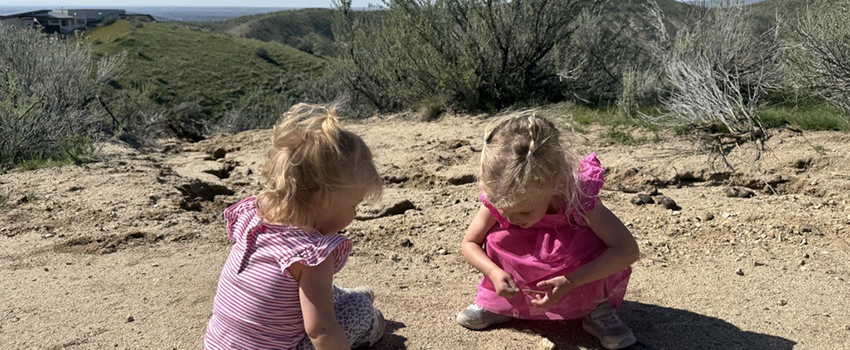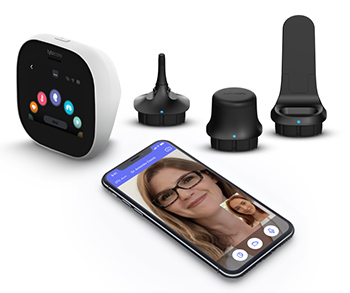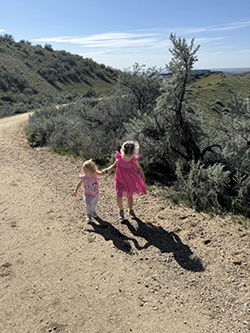Next steps for St. Luke's families' health care begin to take shape via new technology

The Jenkinson family is like many others: working parents, young children, lots on the plate.
Unlike many others, however, the Jenkinsons have at their disposal a small kit of medical equipment connecting them to St. Luke’s physicians. In the month or so since the kit arrived at the family’s home, Ariel Jenkinson said, multiple clinic and pharmacy trips have been avoided and hours of time have been saved – not to mention the comfort that comes with, essentially, having St. Luke’s-level care within arm’s reach.
The Jenkinsons are among the nearly 1,300 families, many with young children, who are early adopters of technology provided by TytoCare, a New York company that St. Luke’s is working with to address some of the thornier problems of health care: access and affordability.
The technology is likely to roll out in stages among other populations, and the team tasked with designing its use is only now putting into place some of the tracking wanted to determine its usefulness and success.
For Ariel, the mother of an 18-month-old and a 3-year-old, both with a history of ear infections, the verdict is already in.
“I wanted to see the technology, my whole family is in Idaho and I want St. Luke’s care from anywhere,” she said. “The day I got it, the next day we used it.”

The kit works with a smart phone and the Jenkinsons’ myChart access. After a set-up conversation with the TytoCare tech crew, a bit of charging time and a text confirmation, Jenkinson felt ready to use the monitors for checking ears, mouth and tongue, and chest.
“It’s super easy,” she said.
Not a moment too soon. The following day was the first kid trial run. With the family pediatrician a half-mile and a “nightmare” traffic snarl away, Jenkinson used the kit during an online visit with a St. Luke’s physician. The time between arranging the consult and being seen? Fifteen minutes. The time saved by not getting two children out of a house and into a vehicle, sitting in traffic, filling out paper, waiting to be seen was invaluable.
“It’s 6 o’clock at night, but we can be, ‘OK, tomorrow we can go in and see her doctor.’ It was the comfort of knowing I was not going to be in the ER at 3 a.m.,” she said.
Right now, use is limited, primarily to some families in Idaho and Oregon, during extended daytime hours. But TytoCare, and St. Luke’s, know that many additional populations might come along: older patients, patients with complex and chronic conditions, pregnant patients and rural residents, among them. It can take the load off emergency rooms and clinics, and the ER and clinic users who lack other options. There are also kit extensions, such as a blood pressure monitor, that could expand its uses.
There are two lines of the TytoCare service that St. Luke’s has engaged with: TytoHome, which the Jenkinsons and other families are part of; and TytoClinic, meant to extend care in such settings as clinics, libraries, schools and businesses. Ariel Jenkinson has on at least one occasion turned her kitchen into a mini-clinic; grandparents have used it while caring for their kids’ kids. It’s easy to imagine how such technology, combined with the judicious use of skilled clinicians’ time, could solve for many of the medical bottlenecks Idaho – and the nation – face.
Kelcy Mann is the product director who led implementation efforts on the St. Luke’s side.
“We are looking at this current population to see what barrier reduction is being achieved,” she said. “We’re here to remove barriers, and we feel like it needs that core tenet of doing that, and if we’re seeing success through this program, then we will expand.
“We’re looking at what other programs can we tap into to fit our broader member population.”
Anecdotally, there has been excitement about the innovation, Mann said. And in a state known for ongoing clinician shortages, with a growing population, that is perhaps not surprising.
“This is providing care in a way that we haven’t previously,” she said. “We’re putting our money where our mouth is. It says, ‘You matter to us.’”
Abby Losinski, St. Luke’s outpatient telehealth/on-demand director, hears the difference it makes from patients.
There is the Midvale family that has made their kit available to a child’s teacher and others, creating a little health hub about an hour away from other clinical care.
There are the patients in Caldwell, Kimberly and Kuna, again otherwise facing logistical challenges to quick, convenient, in-person care. And the 5-year-old in Meridian but felled by an ear infection after hours, for whom the emergency room would have been the likely next alternative.

There is a Boise family, all of whom had the flu but who were able to use the TytoCare connection with their St. Luke’s provider to quickly assess a 9-year-old with a very high fever and in no condition to visit urgent care. Testing was arranged and a diagnosis of strep and flu quickly followed, along with prescription pickup. The process was repeated for the younger child, who followed in her brother’s footsteps.
There is the Midvale youngster, seen through the TytoCare connection for an ear infection on Christmas Eve. When everything was closed, the service kept him – and his family – from needing to leave home for what would most likely have been a costly solution.
“We’re keeping them out of the ED,” Losinski said. “We’re reducing the total cost of care.
“You can’t get any better than that as far as health care goes, right?”
Participants, Losinski said, have been “overwhelmingly appreciative” of the service, “especially families with more than one child. They’d otherwise have to bring everybody into the clinic.
“We’re able to provide something, not just to one health plan member, but to the community as a whole,” she said.
The Jenkinsons’ kit most recently was deployed when Ariel Jenkinson experienced pink eye (“I didn’t even leave my house to be treated.”). And because users can be anywhere in the state, the kit can travel with her to North Idaho to visit family.
“When I fly to Moscow, I don’t want to be in that urgent care with my kids,” she said. “The comfort of being able to fly with that … at least we can call in and get some help” if needed.
“I am a fan,” she said, adding that there has been a common response when she has explained it to others:
“‘When we had kids, I wish we had this.’ It does provide parental comfort.
“It does seem like it’s going to revolutionize care,” she said.
About The Author
Roya Camp works in the St. Luke’s Communications department.

